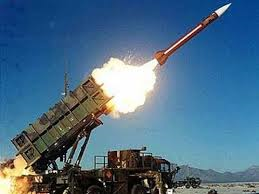The Pentagon’s Strategy for World Domination: Full Spectrum Dominance, from Asia to Africa

First published in August 2014
Current US military space policy is primarily geared toward two countries, China and Russia.
In May 2000 the Washington Post published an article called “For Pentagon, Asia Moving to Forefront.” The article stated that, “The Pentagon is looking at Asia as the most likely arena for future military conflict, or at least competition.” The article said the US would double its military presence in the region and essentially attempt to manage China.
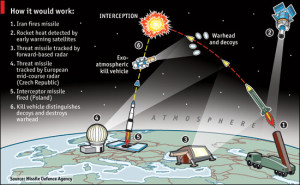 The Pentagon’s missile system.
The Pentagon’s missile system.
The Pentagon has become the primary resource extraction service for corporate capital. Whether it is Caspian Sea oil and natural gas, rare earth minerals found in Africa, Libya’s oil deposits, or Venezuelan oil, the US’s increasingly high-tech military is on the case.
President Obama’s former National Security Adviser, Gen. James Jones had previously served as the Supreme Allied Commander of NATO. In 2006, Gen. Jones told the media,
“NATO is developing a special plan to safeguard oil and gas fields in the [Caspian Sea] region…. Our strategic goal is to expand to Eastern Europe and Africa.”
In a past quadrennial National Intelligence Strategy report, former U.S. Director of National Intelligence Dennis Blair claimed that Russia “may continue to seek avenues for reasserting power and influence in ways that complicate U.S. interests…[and] China competes for the same resources the United States needs, and is in the process of rapidly modernizing its military.”
Using NATO as a military tool, the US is now surrounding Russia and easily dragged the supposedly European-based alliance into the Afghanistan war and Libya attack. The US is turning NATO into a global military alliance, even to be used in the Asian-Pacific region.
ENERGY & MISSILE OFFENSE
In mid-March of 2009 the Pentagon’s Missile Defense Agency (MDA) held a conference in Washington. At that meeting Sen. Carl Levin (D-MI) stated, “Missile defense is an important element of our nation’s defense. For example, it is a high priority to field effective defenses for our forward-deployed forces against the many hundreds of existing short- and medium-range missiles.”
Patriot missiles.
The Obama administration is currently deploying “missile defense” (MD) systems in Turkey, Romania, Poland and on Navy destroyers entering the Black Sea. The NATO military noose is tightening around Russia.
Russia has the world’s largest deposits of natural gas and significant supplies of oil. The US has recently built military bases in Romania and Bulgaria and will soon be adding more in Albania. NATO has expanded eastward into Latvia, Lithuania and Estonia, right on Russia’s border. Georgia, Ukraine, Sweden and Finland are also on the list to become members of the cancerous NATO.
An Indian journalist observes,
“The arc of encirclement of Russia gets strengthened. NATO ties facilitate the [eventual] deployment of the US missile defense system in Georgia. The US aims to have a chain of countries tied to ‘partnerships’ with NATO brought into its missile defense system – stretching from its allies in the Baltic to those in Central Europe. The ultimate objective of this is to neutralize the strategic capability of Russia and China and to establish its nuclear superiority. The National Defense Strategy document, issued by the Pentagon on July 31, 2008, portrays Washington’s perception of a resurgent Russia and a rising China as potential adversaries.”
Just as we have seen the balkanization of Yugoslavia, Libya, and Iraq by US-NATO it appears that the same strategy has been developed for Russia. With NATO’s continuing military encirclement of Russia the plan appears to be to draw Moscow into a military quagmire in Ukraine that will weaken that nation. The Rand Corporation has studies that call for the break-up of Russia into many smaller pieces thus giving western corporations better access to the vast resource base available there.
The recent announcement by BRICS (Brazil, Russia, India, China, South Africa) that they have created a $100 billion international development bank to rival the IMF and World Bank has angered western corporate controlled governments who don’t want any challenge to their management of the global economy. Directly after the BRICS announcement we witnessed an escalation of the US-NATO funded and directed civil war in Ukraine.
The Harper government is now recommending that Canada join the US missile defense program. Canadian military corporations are itching to open the flood gates to the national treasury – the profits from a junior partnership with the US in an arms race in space are too much to pass up. But first more cuts must be made to the Canadian national health care program and other valuable social welfare programs. In the US the military industrial complex has targeted the “entitlement programs” – Social Security, Medicare, Medicaid and what is left of “welfare” for defunding to help pay for the expensive military space technology agenda.
Canada has also undertaken the construction of “armed combat vessels” at the Irving Shipyard in Halifax. This $25 billion program, the largest military appropriation in Canadian history, was supported by every political party in the country. Why does Canada need such a monumental war ship building program?
THE NAVY’S EXPANDING ROLE
As ice melts in the Arctic, the US Navy anticipates that it will have to increase its presence in the region to “protect shipping”. Over the past 25 years, the Arctic has seen a 40% reduction in ice as a result of global warming. Maine’s Independent Senator Angus King recently wrote “gas and oil reserves that were previously inaccessible” will soon be available for extraction. Last spring Sen. King took a ride on a US nuclear submarine under the Arctic ice. Also along for the ride was Admiral Jonathan Greenert, the chief of naval operations, who told the New York Times: “We need to be sure that our sensors, weapons and people are proficient in this part of the world,” so that we can “own the undersea domain and get anywhere there.”
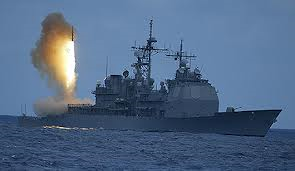
A new Navy report called “US Navy Arctic Roadmap: 2014-2030” states: “Ice in the Arctic has been receding faster than we previously thought…and offers an increase in activity.” The Arctic region holds a plethora of undiscovered fossil fuels and natural resources, including an estimated 90 billion barrels of oil, 1,669 trillion cubic feet of natural gas and 44 billion barrels of natural gas liquids, the roadmap says.
The report warns that the Navy will face serious logistical challenges and will need to examine ways to distribute fuel in the region to “air and surface platforms”. Operating bases will be needed to host deployed military personnel. Partnerships with nations that border the Arctic and more warships will be needed to ensure that the undersea resources are kept in the hands of US-NATO and away from competitors like Russia.
US Secretary of War Chuck Hagel stated in late 2013 that, “By taking advantage of multilateral training opportunities with partners in the region, we will enhance our cold-weather operational experience, and strengthen our military-to-military ties with other Arctic nations.”
SCUPPERING PEACE
President Obama has in the past called for the abolition of nuclear weapons. The Russians, watching an advancing NATO and MD deployments near their borders, are telling the world that any real hopes for serious nuclear weapons reductions are in jeopardy.
Russia and China attempt to prohibit space weapons at the United Nations.
Former Soviet president Mikhail Gorbachev delivered the opening address at the “Overcoming Nuclear Dangers” conference in Rome on April 16, 2009. He noted, “Unless we address the need to demilitarize international relations, reduce military budgets, put an end to the creation of new kinds of weapons and prevent weaponization of outer space, all talk about a nuclear-weapon-free world will be just inconsequential rhetoric.”
The entire US military empire is tied together using space technology. With military satellites in space the US can see virtually everything on the Earth, can intercept all communications on the planet, and can target virtually any place at any time. Russia and China understand that the US military goal is to achieve “full spectrum dominance” on behalf of corporate capital.
Using new space technologies to coordinate and direct modern warfare also enables the military industrial complex to reap massive profits as it constructs the architecture for what the aerospace industry claims will be the “largest industrial project” in Earth history.
TARGET: ASIA
The deployment of Navy Aegis destroyers in the Asian-Pacific region, with MD interceptors on-board, ostensibly to protect against North Korean missile launches, gives the US greater ability to launch preemptive first-strike attacks on China.
The US now has 30 ground-based MD interceptors deployed in South Korea. Many peace activists there maintain that the ultimate target of these systems is not North Korea, but China and Russia.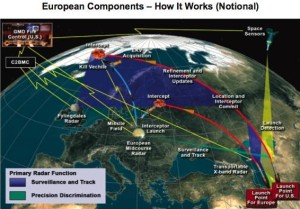
Europe’s leaders are complicit in Full Spectrum Dominance.
The current US military expansion underway in Hawaii, South Korea, Japan, Guam, Okinawa, Taiwan, Australia, Philippines and other Pacific nations is indeed a key strategy in this offensive “pivot” to control China.
An additional US goal is to have the “host” countries make significant contributions toward helping the Pentagon cover the cost of this massively expensive escalation.
For many years the US Space Command has been annually war gaming a first-strike attack on China. Set in the year 2017 the Pentagon first launches the military space plan that flies through the heavens and unleashes a devastating first-strike attack on China’s nuclear forces – part of the new “Global Strike” program.
In the war game China then attempts to launch a retaliatory strike with its tens of nuclear missiles capable of hitting the west coast of the continental US. But US “missile defense” systems, currently deployed in Japan, South Korea, Australia, Guam and Taiwan, help take out China’s disabled nuclear response. 
Peaceful protestors, Japan.
Obama’s former Secretary of Defense Robert Gates’ comments were quite revealing in 2009 when he said, “We’re converting more Navy Aegis ships to have ballistic missile defense that would help against China.”
Missile defense, sold to the public as a purely defensive system, is really designed by the Pentagon to be the shield after the first-strike sword has lunged into the heart of a particular nation’s nuclear arsenal.
Living in Bath, Maine, I have a special perspective on this US-China military competition. In my town, the Navy builds the Aegis destroyers that are outfitted with MD systems. Congressional leaders from my state maintain that more Pentagon funds for Aegis shipbuilding are needed to “contain” China.
Renowned author Noam Chomsky says US foreign and military policy is now all about controlling most of the world’s oil supply as a “lever of world domination.” One way to keep Europe, China, India and other emerging markets dependent on the US and in sync with its policies is to maintain control of the fossil fuel supply they’re reliant on. Even as the US economy is collapsing, the Pentagon appears to be saying, whoever controls the keys to the world’s economic engine still remains in charge.
China, for example, imports up to 80% of its oil on ships through the Yellow Sea. If any competitor nation was able to militarily control that transit route and choke off China’s oil supply, its economy could be held hostage.
One is able to see how the Pentagon will use the South Korean Navy base on Jeju Island, now being constructed despite a seven-year determined non-violent campaign opposing the base, to support  the potential coastal blockade of China.
the potential coastal blockade of China.
Victim of Anglo-American nuclear weapons: Fallujah, 2004.
CONCLUSIONS
For many years Russia and China have introduced resolutions at the UN calling for negotiations on a new treaty that would ban weapons in space.
Since the mid-‘80s every UN member nation has supported the “Prevention of an Arms Race in Outer Space” (PAROS) resolution, with the exception of the US, Israel, and Micronesia.
This was true during the Clinton presidency as well as during the reign of George W. Bush and now under Obama as well.
 Victim of US nuclear weapons: Hiroshima, 1945.
Victim of US nuclear weapons: Hiroshima, 1945.
A full-blown arms race between the US, Russia and China will be a disaster for the world and would make life on Earth less secure. At the very time that global resources are urgently needed to deal with the coming harsh realities of climate change and growing poverty, we can hardly afford to see more money wasted on the further militarization of space and greater superpower conflict.
The Pentagon actually has the largest carbon boot print on the planet. The US insisted that the Pentagon be excluded from the Kyoto climate change protocols and refused to sign the agreements unless the Pentagon was exempted.
As the US undertakes arming the world to the benefit of corporate globalization our local communities have become addicted to military spending. As we oppose the aggressive US military empire overseas we must also talk about the job issue back at home. Calling for conversion of the military industrial complex, demanding that our industrial base be transformed to create a renewable energy infrastructure for the 21st century, helps us come into coalition with weapons production workers who must now support the killing machine if they hope to feed their families.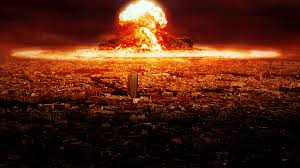
Image: UK Ministry of Defence warns of new technologies’ potential to trigger a ‘doomsday scenario’
Studies have long shown that conversion from military production to creating needed systems like rail, solar or wind turbines not only help deal with the challenges of climate change but also create many more jobs.
It’s ultimately a question about the soul of the nation – what does it say about us as a people when we continue to build weapons to kill people around the world so workers can put food on the table back home?
What is needed now more than ever is unified global campaigning across issue lines. Peace, social justice, environment, labor and other movements must work harder to link our issues and build integrated grassroots movements against the destructive power of the corporate oligarchies that run most of our western governments. The rush to privatize social welfare and the privatization of foreign and military policy must be challenged if we are to successfully protect the future generations.
Bruce K. Gagnon is the Coordinator of the Global Network Against Weapons & Nuclear Power in Space and is author of the book Come Together Right Now: Organizing Stories from a Fading Empire. He lives in Bath, Maine. www.space4peace.org


